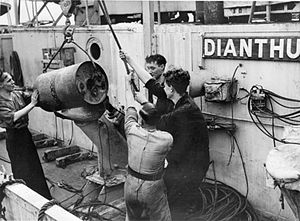| Convoy HX 212 | |||||||
|---|---|---|---|---|---|---|---|
| Part of Battle of the Atlantic | |||||||
 A depth charge being loaded onto a depth-charge thrower aboard the corvette HMS Dianthus | |||||||
| |||||||
| Belligerents | |||||||
|
|
| ||||||
| Commanders and leaders | |||||||
|
VADM W de M Egerton CDR T. L. Lewis USCG[1] | Admiral Karl Dönitz | ||||||
| Strength | |||||||
|
43 freighters 1 destroyer 1 cutter 6 corvettes | 17 submarines | ||||||
| Casualties and losses | |||||||
|
6 freighters sunk (51,997 GRT) 243 killed/drowned | |||||||
Convoy HX 212 was the 212th of the numbered series of World War II HX convoys of merchant ships from HalifaX to Liverpool.[2] The ships departed New York City on 18 October 1942[3] and were met on 23 October by Mid-Ocean Escort Force Group A-3 consisting of the United States Coast Guard Treasury-class cutter USCGC Campbell, the destroyer Badger and the Flower-class corvettes Dianthus, Rosthern, Trillium, Dauphin, Alberni, Summerside and Ville de Quebec. The first five escorts had worked together previously, but the last three corvettes were attached to the convoy only for passage to the eastern Atlantic in preparation for assignments on Operation Torch. Summerside was the only escort equipped with modern Type 271 centimeter-wavelength radar.[4]